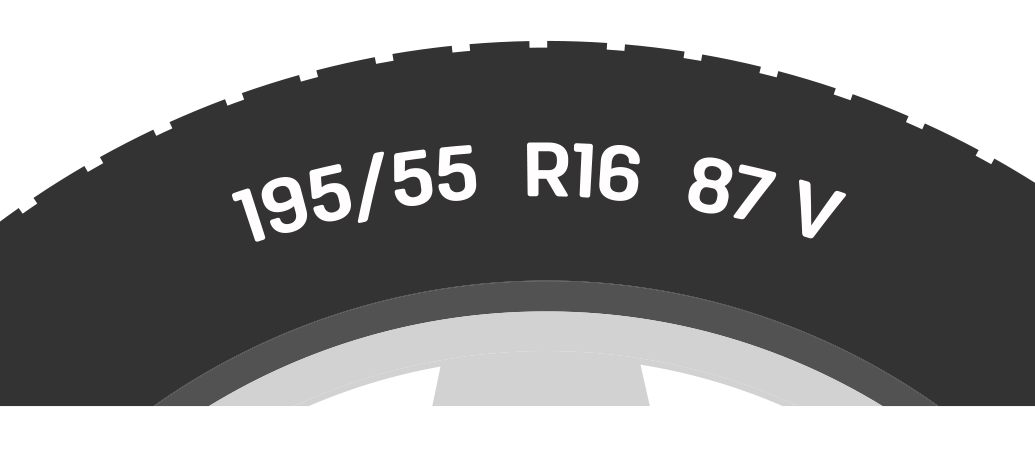Tyre speed ratings tell you the maximum speed that particular tyre is legally approved for. This measurement ensures that the tyre you buy is appropriate – and safe – for the speed of the car it’s fitted on.
Where do I find the tyre speed rating?
The speed rating is displayed on the tyre’s sidewall, after the load rating. In this example, the car’s speed rating is W, which indicates that it has been legally approved for use up to 168 mph.
 Speed rating on a tyre sidewall
Speed rating on a tyre sidewall
How is the speed rating calculated?
Speed ratings are based on laboratory tests in which the tyre is run at 6.2 mph steps, in 10 minute increments, until the required speed has been met. To receive its rating it must demonstrate that it can sustain a particular speed when tested with simulated loads.
The speed rating is represented by a letter – A being the lowest and Y being the highest. As you will see on the chart below, there are some anomalies as car manufacturers have increases the speeds of their vehicles and speed ratings have been introduced to match them.
| Speed Rating | Maximum Speed | Type/Vehicle Type |
| L | 75 mph 120 km/h | Off-Road & Light Truck Tyres |
| M | 81 mph 130 km/h | Temporary Spare Tyre |
| N | 87 mph 140 km/h | Tempoary Spare Tyre |
| Q | 99 mph 160 km/h | Winter 4x4 |
| R | 106 mph 170 km/h | Heavy Duty Light Truck |
| S | 112 mph 180 km/h | Family Sedans & Vans |
| T | 118 mph 190 km/h | Family Sedans & Vans |
| U | 124 mph 200 km/h | Sedans & Coupes |
| H | 130 mph 210 km/h | Sport Sedans & Coupes |
| V | 149 mph 240 km/h | Sport Cars |
| Z | 149+ mph 240+ km/h | Sport Cars |
| W | 168 mph 270 km/h | Exotic Sport Cars |
| Y | 186 mph 300 km/h | Exotic Sport Cars |
| (Y) | 186+ mph 300+ km/h | Exotic Sport Cars |
Are speed ratings just about speed?
No. They’re also about ride comfort, traction, tread wear and cornering ability. A higher speed rating generally offers better grip and stopping power, but it may have a lower tread life and reduced performance in cold weather. That’s why V, Z, W and Y-rated tyres are usually better suited to high performance vehicles in warmer climates.
You can increase the speed rating of your vehicle’s tyres for improved performance, but can never decrease it without reducing the vehicle’s top speed to that of the lower speed rating selected.
Can I mix speed ratings on my vehicles tyres?
If you are going to mix speed ratings, which we don’t recommend, make sure the lower rated tyres are on the front axle, regardless of whether your vehicle is front-, rear- or four-wheel drive. This is to prevent a potential oversteer scenario. Bear in mind that all tyres must be appropriate for the vehicle and you should drive no faster than your lowest rated tyres.
We would always recommend that the same size and type of tyre, with the same speed ratings, are fitted on all tyres.
Related Topics
-
 2023/03/31Find out more about the differences between asymmetrical and directional tyre tread patterns, and discover how Uniroyal has combined the best of both with the RainSport 3.Which different tread patterns are there?Read more
2023/03/31Find out more about the differences between asymmetrical and directional tyre tread patterns, and discover how Uniroyal has combined the best of both with the RainSport 3.Which different tread patterns are there?Read more -
 2023/03/31It’s important that you know how to check your tyres’ tread depth. After all, the tread depth affects handling and provides grip with the road surface. The deeper it is, the more grip you’ll have.Tread depthRead more
2023/03/31It’s important that you know how to check your tyres’ tread depth. After all, the tread depth affects handling and provides grip with the road surface. The deeper it is, the more grip you’ll have.Tread depthRead more
